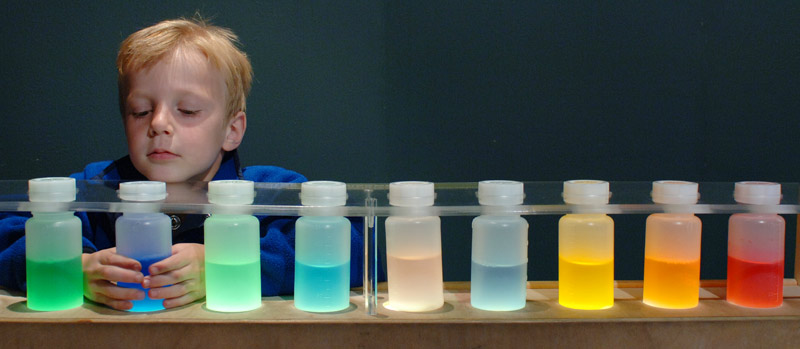
People can recognize thousands of odors—but there’s more to smell than what meets the nose. We also rely on visual cues to identify faint or ambiguous scents.
Research on perception suggests that when what we see “matches” what we smell (say, a brown cake that smells like chocolate), the scent is stronger and more pleasant than when sight and sound don’t match. “Mismatches” between visual and olfactory stimuli may also make it harder to identify what we’re smelling.
This activity lets you experience how the way something looks can change your interpretation of how it smells.
What you need:
- A bunch of clear bottles (12 or 16 oz. plastic water bottles work well)
- Water
- Food coloring
- Scents: Pick ones with strong color associations. (Mom’s perfume is probably not a good choice.) You also want simple, easily recognizable odors; most people won’t have an expectation of amber’s smell, let alone what color it “goes with.” Food flavorings (check the market’s bakery section) and home fragrance oils are good places to start. Look for scents in clear liquid form.
Getting ready:
You need 2 bottles for each scent (and make sure they’re clean). Use colored water matching the scent in one bottle (red water for strawberry scent, green water for mint), and mismatched water in the other bottle (green water for strawberry, blue water for lemon).
Your goal is to make the members of a scent pair smell the same. Both strawberry-scented waters should smell equally strong and sweet, even though you’re making them different colors.
Be precise! Use an eyedropper or measuring spoon for equal doses of scent in each member of a scent pair. Mix them with equal amounts of water, too.
Doing the experiment:
Now you’ve got a line of colorful potions, half color/smell matches and half mismatches. Uncap them all and ask a friend or family member to take a sniff of each.
Can they identify the smells and find both members of each pair? Does one strawberry liquid smell stronger or sweeter than the other? What about the other pairs? You made sure that each member of a pair smelled the same, so differences in the way they smell are probably due to the way they look . The eyes fooled the nose!
Something to think about:
Can you think of other “crossovers” between one sense and another? For example, do some sounds look a certain way (“green,” “sparkly,” “dark”) or have a particular feel (“rough,” “smooth,” “jagged”)? For some people, connections between senses are very strong, a phenomenon called synesthesia .



